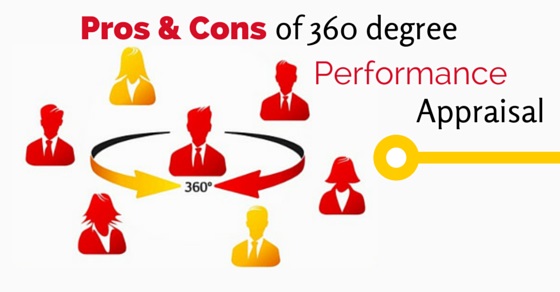When an employee is recruited, he has to undertake certain responsibilities and the company has also set certain standards for him to excel.
To check how he has undertaken his job responsibilities and measure his productivity, the procedure of employee performance appraisal is undertaken.
However, 45% of HR leaders feel that the current performance appraisal procedure is undertaken does not accurately gauge the employees’ work.
While 44% of employees do not consider the fact that their bosses are honest when they are doing their performance evaluation or appraisal.
A Meta-analysis undertaken of 607 studies indicated that the performance level of the employer decreased considerably after the performance appraisal was over.
It is important here that an appraisal procedure is undertaken which is effective and accurately evaluates the performance of the employee and encourages him to grow in the company.
In this regard, the 360-degree performance appraisal system is popular and widely accepted among the HR fraternity of various companies. In the next few seconds, we would try to understand what the basic principles are of 360-degree performance appraisal and analyze the pros and cons of it.
What is a 360-degree Performance Appraisal?
The 360-degree performance appraisal process is a kind of employee review process which is done by the employee’s coworkers who work along with him in the same organization. The whole process is done by collecting feedbacks and gathered together to form a report based on which the employee is finally reviewed.
The main reason for using such type of appraisal process is for the betterment and development of the employee. This not only helps the employee to grow but also aids in boosting the productivity of the organization.
It is also a good way to analyze the employees’ strengths and weaknesses and work on them.
Some of the prime reasons why most organizations use this 360-degree performance appraisal review process are,
- To better analyze the employee performance
- To assess the development plan that needs to be implemented on the employee
- Can have unbiased feedback from the employees which help in maintaining organizational justice
Though performing the 360-degree performance appraisal process is a little complicated it is mainly helpful for long term development and building of better relationships among the co-workers.
Understanding the Basics of 360 Degree Performance Appraisal:
The main principle behind the 360-degree performance appraisal is that, when an employee receives feedback at the workplace from multiple people regarding his overall performance, then he receives a complete picture of how effective he is at work and what needs to be done to develop him personally and professionally. This is because he can meet the standards set for him by the company.
Researchers at San Diego State University are of the opinion that the 360-degree performance appraisal system connects all the employees of the organization and enhances the interpersonal relationship between them.
Overall this helps the company to grow. The Esso Research and Engineering Company was the first company to use the 360-degree performance appraisal system in the 1950s and after that, this appraisal system gained much momentum in the 1990s.
Objectives of 360-degree Performance Appraisal :
The objectives of 360-degree performance appraisal change from one organization to another. Though the implementation and usage of it may differ the main soul of this process remains the same.
The prime objective of this type of appraisal process is to analyze employee performance and provide better reviews that help him grow and improve himself in terms of work. This is even beneficial for the organization as improved employee performance would help in increasing organizational success.
The best part is that the feedback received from other workers would not be biased and impartial towards the employee.
360 Degree Performance Appraisal Process:
The 360-degree performance appraisal process works well only if it is organized and performed in a proper way. This type of review process takes time and there would be a number of steps involved in it. The right order of performing this review process would give us fruitful results.
As this 360-degree performance review process is an advanced form of the review process, this need to be executed in a step by step manner.
Some of the things that need to be considered and followed while performing this review process are
- Selecting the people carefully who would be rating
- Communicating with the people who will be included in this process
- Survey distribution is done which containing the notification and questions
- Submission of the questionnaires within the time limit
- Feedback received should be handled confidentially
- The report is prepared based on the feedback respectively
- A development plan is designed for the employee undergoing review
- Re-evaluating for assessing the improvement or final outcome
How 360 Degree Performance Appraisal is Implemented?
The U.S. Office of Personnel Management is of the opinion that a minimum of 12 raters are used for the appraisal evaluation of a single employee. Here the raters could be superiors, colleagues, team members, and even customers.
The HR professional collects the data derived from the raters and then fills up the employee performance appraisal form. The HR managers are of the opinion that since the feedback for an employee comes from multi-people, the feedback is more reliable and accurate.
The questionnaire given to the raters assesses the behavior of the employee, the level of skill he has to do specific work and also the knowledge he has in general regarding his industry, company and his own job.
Advantages and Disadvantages of 360 Degree Performance Appraisal:
| Advantages of 360 Degree Performance Appraisal | Disadvantages of 360 Degree Performance Appraisal |
| Creates a channel of open communication among employees | Very expensive |
| Enjoy a perception of how others see them | The participation of the immediate superior is limited |
| Helps to improve the employee performance considerable | Sometimes feedbacks become personal in nature |
| The importance of the feedback |
Advantages of 360 Degree Performance Appraisal:
1. Creates a channel of open communication among employees:
When a company adopts the 360-degree performance appraisal system, the employees working in the company are required to rate each other’s work.
Thus an environment rich in open communication develops and employers communicate the problems that are present and offer solutions to combat also. This helps the company to solve issues that might have created problems otherwise.
2. Enjoy a perception of how others see them:
In the traditional appraisal system, the viewpoint is mainly of the management. However, when a company undertakes a 360-degree performance appraisal system, the feedback for an employee comes from multiple levels.
An employee can perceive how his team members, customers, and superiors view him and take steps accordingly to improve him.
3. Helps to improve the employee performance considerable:
One of the benefits of using the 360-degree performance appraisal system is the feedback help to enhance the personal effects of the employee.
This is very good when a company is in the service industry and also wants to constantly improve the quality of work undertaken by each of its employees.
4. The importance of the feedback:
Performance appraisal always creates an environment of tension for the employee who is being appraised.
But when the 360-degree performance appraisal system is used well, then the appraisal is more like positive feedback and the employee can take in the feedback in a more positive manner.
This would help the employee to understand his shortcomings and make an effort to improve in the near future. An improved employee would help the company to grow in many ways.
Disadvantages of 360 Degree Performance Appraisal:
The following mentioned are few disadvantages of 360-degree feedback performance appraisal.
1. Very expensive:
While studying the 360-degree performance appraisal system, the researchers from The Medical College of Wisconsin found out that this appraisal system was time-consuming and it also increased the overall workload of the employee.
Researchers from the University of Rhode Island also found out that since the raters had to do their daily work and also participate in the appraisal system, the feedback from the raters sometimes indicated low motivation and a decrease in satisfaction for the employees.
The employee here might also become overburdened and might suddenly take a decision to leave the company in this regard.
2. The participation of the immediate superior is limited:
Since the 360-degree performance appraisal system involves feedback from multiple levels in the company, the immediate superior does not get much involved.
Marion Their from Expanding Thoughts which is located in Boulder explains that, when using the 360-degree evaluation or effective performance appraisal the manager should not casually walk in and just point out the areas the employee needs to improve and then walk away, it is a strict NO.
She also tells that this happens frequently and is not uncommon. Here it is important that the immediate superior should understand that the multiple level feedback can work for the employee and he should also take a major initiative in it. Otherwise, the appraisal system would not work for the employee
3. Sometimes feedbacks become personal in nature:
When a company undertakes a 360-degree appraisal method, the HR should see to it that the feedback from the raters are constructive in nature.
The role of the employee should be understood when feedback is taken from a rater.
For example, Lynda Zugec working in New York at the Workforce Consultants explains that if an employee does not deal on a day to day bases with a customer or a client, feedback from them is not necessary.
If the feedback is taken, then the feedback given on the employee would be unfair and not accurate.
The Importance of Maintaining the Confidentiality of Data:
If an employee is being rated for the first time using the 360 degrees employee appraisal system, then he might worry about the confidentiality of the data.
Here the employee has to be assured that the data in the feedback would be kept confidential and the raters will not discuss his evaluation openly among themselves.
Dick Grote, the writer of “How to be Good at Performance Appraisals?” explains here that the company should not allow political collaborations among office groups to be undertaken, where people in a group pat each other’s back and benefit themselves.
Active follow-up needed:
When companies undertake a 360 performance review or 360-degree appraisal system, they usually have a single follow up with the employee, annually.
But since changes in behavior also are undertaken the follow up should be more often and within once in every 3 to 4 months.
This would help the employee improve considerably and the company would gain from it.
360-degree Feedback Questionnaire:
The following mentioned are a few questions that would be included in the survey form which will be sent to the people who would rate. The questions here are segmented into different sections so as to assess each skill separately.
Problem-solving attitude:
- What are the skills which this employee has shown to solve the problem?
- Do you believe the employee has less problem-solving skills, and do you recommend any improvements?
- Do you think the problem was solved effectively by this employee?
Leadership skills:
- How effectively this employee contributed through his leadership skills?
- Do you think the employee should improve his leadership qualities to become a great leader?
- Do you believe this employee shows the quality of leadership in their job?
Interpersonal skills:
- When you speak with this employee, do you think the interpersonal skills which shown were acceptable?
- Did you feel any problem with his Interpersonal skills while interacting with this candidate?
- Do you suggest any changes in an employee’s interpersonal skills and relationship development skills?
Efficiency:
- Do you recommend places where the employee can improve?
- Do you think the process and strategy used by the employee are compelling, effective and improving?
Motivation:
- Did you ever experience any lack of motivation level in these employees?
- Do you believe this employee showed motivation towards his task, job, or relationships?
- Do you think this employee committed and motivated others about the success of the organization?
Final Words:
In conclusion, it should be added when a company adopts the 360-degree appraisal system it should train raters who would assess the employee accurately and help him to develop considerably, both in areas of work and personal life.
Otherwise, the whole procedure would be wastage of time and money for the company. It also might de-motivate the employee concerned.
The above mentioned are a few 360-degree feedback advantages and disadvantages. Now that you have read the article it would be great if you can share a few notable comments on the topic discussed above. Also, review and add your feedback which might add an important dimension to the article.











































